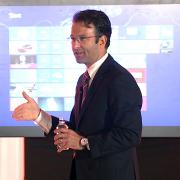Microsoft’s Judson Althoff Encourages Companies to Practice What They Preach
Original article published on BizTech on 1/1/14.
By using its cloud services and software tools internally, Microsoft energizes its sales force and shows customers they are selling proven business tools.

When Judson Althoff became president of Microsoft North America earlier this year, he was taken by the company’s portfolio of cloud services, data center capabilities and productivity and data analytics tools.
With such an array of infrastructure and software products available, Judson was eager to put Microsoft’s IT to work managing the company’s sales teams and responding to what he determined were the industry’s four megatrends: mobility, cloud computing, enterprise social media and Big Data.
Althoff explains why the four industry trends are important and how Microsoft is responding.
But Althoff was told that, internally, Microsoft employees were kind of like the cobbler’s children: They often didn’t get to use their company’s own products. Frustrated by stonewalling, Althoff was determined to change the culture so Microsoft could leverage its smart tech tools internally.
“When I took this project on five months ago, I said, ‘Listen, we’re going to run our own business with our own technologies because I believe that’s what we’re asking customers to do, and I just feel a little funny asking my customers to something I’m not willing to do myself.’”
IT You Can Believe In
Microsoft started by leveraging the Windows 8 live-tile grid format to deliver visibility into the company’s internal systems. The dashboard that Althoff uses pulls data from 18 Microsoft systems. He says it’s not only a high-level dashboard, but a system that offers real-time feedback. For example, it shows him a graphical view of the company’s top 10 deals, which he can immediately swipe to the left and drill down into Microsoft’s CRM system.
Althoff talks about how he leveraged Microsoft’s own solutions to boost insights and productivity.
“I can also get information about all of my marketing prospects,” he says. “I can click in to the marketing activity, and can search on a customer again … and see all the marketing activity that’s happened within that account over the last month.”
Althoff can also filter the CRM data by region and line of business. For example, if he wants to look at the status of Microsoft’s Midwest business, he can zoom in graphically and focus on all of the outstanding business the company has in, say, Illinois or Michigan.
“What I can do with this information is snap it immediately into emails, push it out to my VPs of sales across the country, and have them drill down on finding incremental business opportunities within my sales rep community.”
Althoff says this was not custom code work. Microsoft could use these tools to make the sales force more productive because its cloud-based Office 365 service integrates with Windows 8 and off-the-shelf accounting and CRM tools that Microsoft can readily access.
Communication That’s In Sync
There’s also tight integration between the Microsoft Lync unified communications system and Microsoft Outlook. When Althoff sets up a meeting in Outlook, it automatically puts in a link for a Lync meeting. Instead of having to fuss with conference IDs, PINs and passwords to enter a meeting, he and the people he has invited simply click “Join,” and they’re in the meeting.
Althoff explains the tight integration between Microsoft’s UC offerings.
“So there’s my web conferencing solution all-in-one within my Windows 8 computer, no additional fancy PBX equipment,” Althoff says. “And we can show you that Microsoft Lync not only runs on Windows technologies, but it will run on an iPad, an Android phone and even on a PPI board during a presentation.”
To learn more about Judson Althoff and Microsoft’s vision for the future of IT, visit his leadership session.
Steve has more than 30 years of journalism and publishing experience, most of the last 20 of which were spent covering technology. He has covered networking and telecommunications in corporate computing, government and small business environments.
